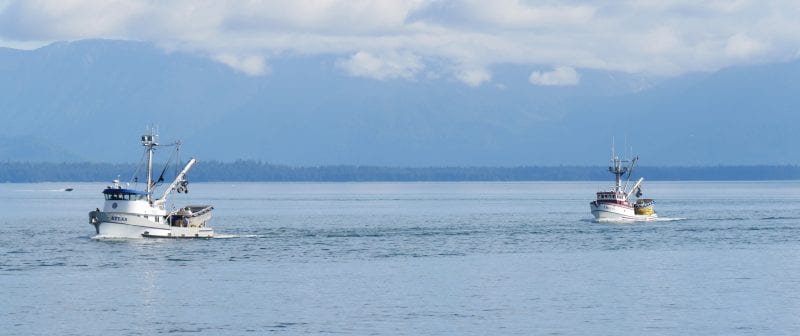
The purse seiners Atlas and Orion enter the Wrangell Narrows near Petersburg in July. (Joe Viechnicki/KFSK)
It’s very early still in the pink salmon season in Southeast Alaska, but so far returns look to be tracking with the pre-season forecast for the region.
Pinks are targeted mainly by the region’s purse seine fleet and either canned or frozen. The Alaska Department of Fish and Game forecast a commercial catch this year of 23 million fish. Managers are expecting something similar to the disappointing season of 2016, the parents of this year’s pinks. That year the catch only hit 18 million and a fishery disaster was declared.
Fish and Game’s pink and chum salmon project leader for Southeast Andy Piston said so far things look like returns are coming back as expected. That is to say very few fish showing up in the northern inside waters and a few returning in the southern Panhandle.
“You know we’re seeing some signs that escapements are building OK in a lot of some of our earlier systems in southern Southeast, Piston said in late July. “So there are some signs that we’ll hopefully be able to have at least a mediocre season down here.”
The catch total for the southern part of the Panhandle through the July 22nd opening was around 600,000 fish, but it’s still very early in the season. Typically pink salmon peak in early- to mid-August. Most of the catch this year is expected to come from southern Southeast. Test fishing has shown generally pretty weak returns to the central and northern inside waters and managers haven’t been opening purse seine fishing for pinks in the northern Panhandle.
The southern part of the region has been experiencing a drought. That means low creek levels could make it tougher for salmon to enter streams and spawn. Piston said that could create some issues if this dry spell continues.
“You know in the earlier systems in particular, you know fish are starting to enter the streams and there’s especially some of our island systems, there’s a lot of places that are getting extremely low,” he explained. “And as we get into August we really need to have some rain so those fish can get in there and can have plenty of oxygen and water to spawn successfully.”
Pinks come back every two years and even and odd year catches have varied pretty widely. The last five even years have averaged a catch of about 25 million fish. But things are just getting going; in a week or two fishery managers will know a lot more about this year’s run.











